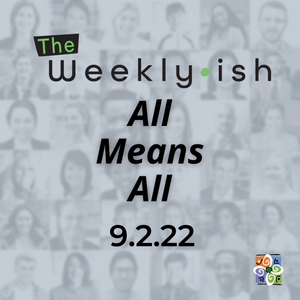
Hi, Y’all!
First a big shoutout to all my kids for leveling up this year. I’m now the proud father of a 16, 13, and 10-year-old. The single-digit days are over.
Thanks for being great kids. I love being your dad.
Oh, and by the way. Welcome to our new subscribers and listeners. Remarkably, we went from 209 downloads for our August 5 edition of the Weeklyish to 700 downloads for our latest episode on August 19. I sincerely appreciate it.
If you are wondering who this Tim Villegas guy is, please check out “The Misunderstood Inclusionist,” for a little background info on me and why I’m extremely fortunate to do what I do.
So, one of the perks of the job is that I get to read and think about inclusion. When I was a special education classroom teacher, I still did this. But I didn’t give myself dedicated time to digest the information.
For this edition of the Weeklyish, I wanted to share two journal articles that I think you’ll find interesting and possibly give you hope for a unified educational system. There is another one that I don’t think deserves any of your time, so I’m not going to mention it. But some themes are not uncommon in any critique of an “all means all” philosophy, and I have a few things to say about that.
First up is an article (from 2020) by Michael Giangreco. It’s called “How Can a Student with Severe Disabilities Be in a Fifth Grade Class When He Can’t Do Fifth-Grade Level Work?” Misapplying the Least Restrictive Environment.
Isn’t that a great title? It is from the journal Research and Practice for Persons with Severe Disabilities.
Here is the big idea: the concept of Least Restrictive Environment or LRE should facilitate inclusive placement for students with extensive support needs. Instead, LRE often is used as justification for a segregated placement in a special education classroom.
How many times have you heard, “well...this student’s LRE is an autism classroom.” I would argue that the Least Restrictive Environment is meant as the general education classroom. All other placements are just plain restrictive.
Here is an excerpt from the article. It’s Giangreco’s concluding statement.
The fact that so many students with severe disabilities are being successfully included in general education placements is evidence that it can be done, and begs the question of why it is happening in some schools and not in others. Even in those situations where students with severe disabilities are placed in general education classes, there is undoubtedly much work that remains to be done because placement in general education classes is necessary but not sufficient to be truly included. In the words of Dr. Martin Luther King Jr., “The arc of the moral universe is long, but it bends toward justice.” The US history of general education class placement of students with severe disabilities has followed this long slow arc toward inclusion and justice. Granted, we still have a long way to go! Whatever steps we can take to continue and speed up the process are important so that more students can benefit from inclusive schooling sooner, rather than later, if at all.
I want to reiterate what Giangreco says here: general education placement is necessary but insufficient. Ok. I’ll get back to that in a minute.
Take a deep breath. Ready for the next one?
This article is “An Interview on District and School Transformation: Practical Approaches to Facilitating Sustainable Systemic Change.” And it’s from a journal called Inclusive Practices from 2021.
If you’ve been following me for any length of time, you’ve probably heard me talk about school districts that are right now changing their practices to become more inclusive. Well in Illinois, there is a special education cooperative that is reimagining what education services look like for all learners.
A regional cooperative has a number of districts that they serve in various ways, but historically through special education classrooms and indirect services like professional development. And so, when Dr. Kurt Schneider came to True North, the focus of the cooperative changed to assist with providing instructional supports and services within general education curriculum and classrooms, so learners could be meaningfully included in their home schools and communities.
Here is an excerpt from t...
09/02/22 • 10 min
Generate a badge
Get a badge for your website that links back to this episode
<a href="https://goodpods.com/podcasts/inclusion-stories-248559/all-means-all-28384470"> <img src="https://storage.googleapis.com/goodpods-images-bucket/badges/generic-badge-1.svg" alt="listen to all means all on goodpods" style="width: 225px" /> </a>
Copy